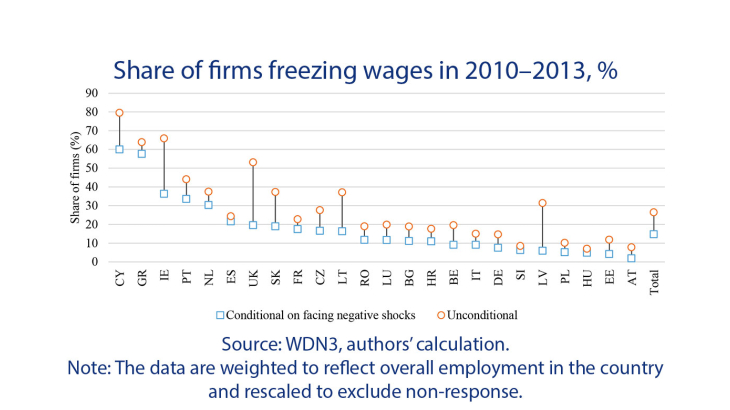Micro-level data on wage variations and survey-based evidence on wage setting have revealed that even in the face of large negative shocks, not only are workers reluctant to accept cuts in their nominal wages, but also firms seem to be unwilling to carry out such cuts. This is referred to as downward nominal wage rigidity (DNWR). The resistance to cutting wages – when economic conditions justify it – in favour of freezing them is of course a major impediment to labour cost adjustment. In the presence of DNWR, a positive rate of inflation is needed to facilitate the adjustment of relative wages. Hence, an inflation rate which is too low could lead, in the presence of DNWR, to long-term unemployment.
However, the relevance of DNWR depends on whether firms have other margins besides base wages to adjust labour costs when needed. It is possible that rigidity has little effect on aggregate employment simply because firms have made adjustments that could be reflected in variables such as profits or productivity. Another possible explanation for the decorrelation between employment and DNWR is that firms may be able to achieve the necessary flexibility that is prevented by nominal wage rigidity by using more flexible pay components, such as performance-related bonuses, commissions and other benefits. Even though employees are less likely to oppose changes in these benefits than in their wages, from firms’ perspective they are also labour costs. That is why the key point when analysing DNWR is whether firms can flexibly adjust total compensation as a whole. It could be the case that the effective degree of DNWR turns out to be lower when one accounts for total compensation, leading to a smaller sacrifice ratio and reduced bending of the Phillips curve.
This paper examines the issue of substitutability and complementarity between the base and non-base wage components raised in the literature. In particular, the paper assesses the role of non-base wage components as a channel of labour cost adjustment in firms facing adverse economic shocks during 2010–2013. It firstly focuses on the relationship between wage rigidities and the use of non-base wage component adjustment. It then analyses the differences in the responses of base wages and non-base wages to shocks.
We use a unique dataset based on a survey of firms from 25 European Union countries undertaken between the end of 2014 and mid-2015 as part of the third wave of the Wage Dynamics Network – a Eurosystem research network created in 2006 and reactivated in 2013 with the main purpose of assessing labour market adjustments in the period 2010–2013.
The main results are the following. About 74% of firms covered in our sample paid bonuses and other performance-related benefits (non-base wage components) in 2013, with an average share of non-base wage components in the total wage bill in 2013 of around 7%. This is lower than in the pre-crisis period (11%). The smaller fraction of non-base wage components in the total wage bill may reflect the slower economic growth in 2013 relative to the pre-crisis period (2002–2007), but it is also suggestive of an increased role of these payments in firms’ labour cost flexibility, as reflected in a higher share of firms using non-base wages as part of their remuneration mechanisms. There is significant heterogeneity in the use of non-base wage reductions by sector and size for firms negatively affected by the economic conditions. A total of 13% of firms cut non-base wage components during 2010–2013, which is substantially larger than the percentage that cut base wages (5%). This is not surprising for the majority of countries given the prevalence of DNWR.
The results indicate that firms that are subject to nominal wage rigidities are more likely to cut non-base wages in order to adjust labour costs in the presence of shocks. Thus, bonuses and benefits played a role as shock absorbers during the period 2010–2013.
While firms which experience a fall in demand are more likely to reduce both base wages and non-base wage components than those that do not suffer any shock, we find that the increase in the probability of reducing non-base wages is higher than that of reducing base wages. Similarly, other negative shocks consistently generate negative effects on wages, with non-base wage components reacting more strongly than base wages to negative shocks. Our evidence also suggests that non-base wage components react more frequently in the case of negative shocks, and these reactions are stronger for non-base wage components than for base wages.
